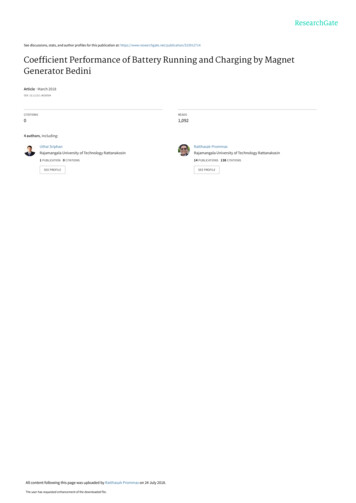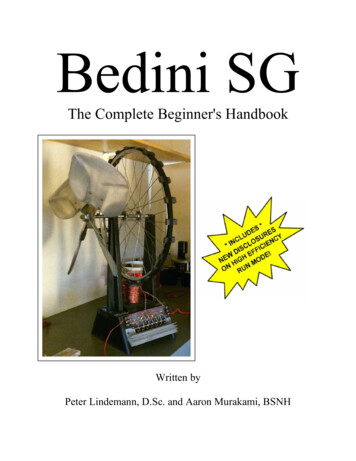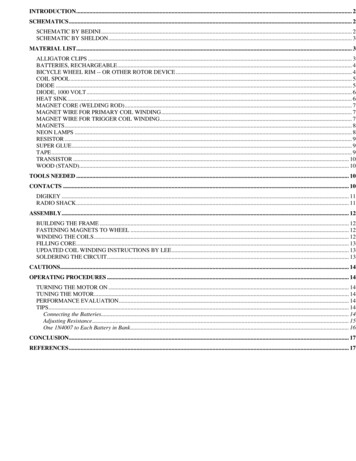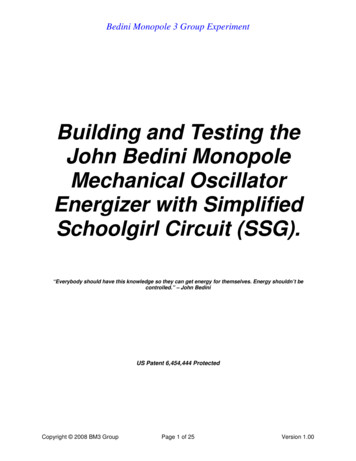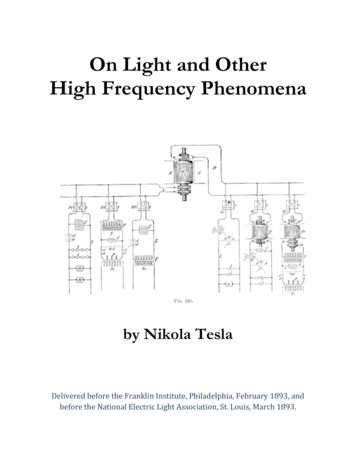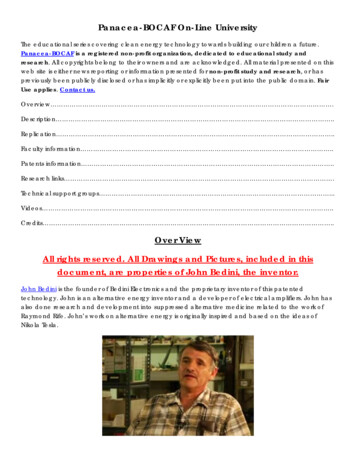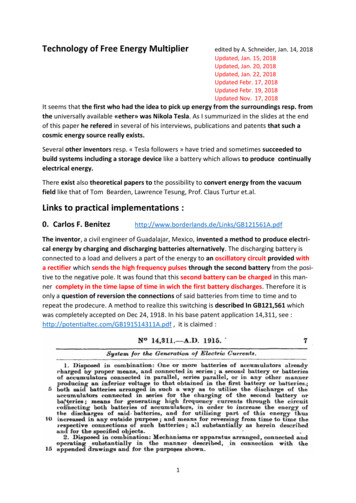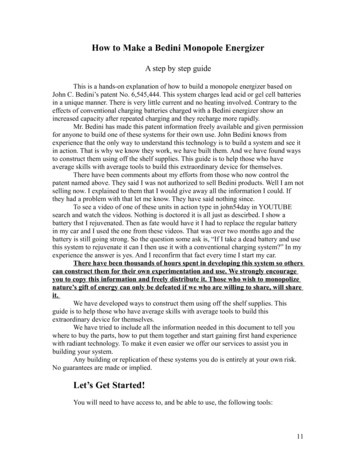
Transcription
How to Make a Bedini Monopole EnergizerA step by step guideThis is a hands-on explanation of how to build a monopole energizer based onJohn C. Bedini’s patent No. 6,545,444. This system charges lead acid or gel cell batteriesin a unique manner. There is very little current and no heating involved. Contrary to theeffects of conventional charging batteries charged with a Bedini energizer show anincreased capacity after repeated charging and they recharge more rapidly.Mr. Bedini has made this patent information freely available and given permissionfor anyone to build one of these systems for their own use. John Bedini knows fromexperience that the only way to understand this technology is to build a system and see itin action. That is why we know they work, we have built them. And we have found waysto construct them using off the shelf supplies. This guide is to help those who haveaverage skills with average tools to build this extraordinary device for themselves.There have been comments about my efforts from those who now control thepatent named above. They said I was not authorized to sell Bedini products. Well I am notselling now. I explained to them that I would give away all the information I could. Ifthey had a problem with that let me know. They have said nothing since.To see a video of one of these units in action type in john54day in YOUTUBEsearch and watch the videos. Nothing is doctored it is all just as descirbed. I show abattery thst I rejuvenated. Then as fate would have it I had to replace the regular batteryin my car and I used the one from these videos. That was over two months ago and thebattery is still going strong. So the question some ask is, “If I take a dead battery and usethis system to rejuvenate it can I then use it with a conventional charging system?” In myexperience the answer is yes. And I reconfirm that fact every time I start my car.There have been thousands of hours spent in developing this system so otherscan construct them for their own experimentation and use. We strongly encourageyou to copy this information and freely distribute it. Those who wish to monopolizenature’s gift of energy can only be defeated if we who are willing to share, will shareit.We have developed ways to construct them using off the shelf supplies. Thisguide is to help those who have average skills with average tools to build thisextraordinary device for themselves.We have tried to include all the information needed in this document to tell youwhere to buy the parts, how to put them together and start gaining first hand experiencewith radiant technology. To make it even easier we offer our services to assist you inbuilding your system.Any building or replication of these systems you do is entirely at your own risk.No guarantees are made or implied.Let’s Get Started!You will need to have access to, and be able to use, the following tools:11
Electric drill for making holes and driving screwsMeasuring tapeSoldering iron½ in open end wrench or medium to small crescent wrenchHack sawRadial or skilsawHot melt glue gunA pair of heavy duty wire cutters or tin snipsNeedle nose pliers (if you have a strong grip this can also be the wire cutters)A volt/ohm meterMasking tape and electrical tapeHere is a diagram of what you will be building. We call it a Kitty Hawk versionbecause it is just the beginning of your adventure into radiant energy use.There are 5 main parts to this device. They are the coil, the rotor, the circuit, theconnecting wires and the base to hold them all together.This is a picture of an expanded version we call the Cactus Express.This model has an amp meter attached which is not part of the kit.22
Here is an overview of the 5 parts.The coil is wound with multiple wires all the same length so it is not aconventional transformer. The first coil on the system has 5 wires all about 100 feet long.Any additional coils would have only 4 wires also 100 feet in length. They are wrappedon a plastic spool and the core is filled with cut welding rods. In the picture you see twocoils on either side of the rotor.The rotor is about 5 inches in diameter by 3 ¾ inches long, made of black ABSplastic. It has a place for a bearing in the center. On the outside circumference are placed4 to 6 ceramic magnets which are taped in place. The rotor pictured above has 6 magnets,double stacked.The circuit is the more technical part. But if you have done any circuit soldering itis a simple circuit. If you have never soldered but would like to try, this is a great place tostart. The components are fairly easy to handle and the circuit is not complex. There aretwo circuits shown in the above picture. The circuit has been designed to be expandableso whether the system has one coil or 12 the same circuit works for all.The base is made of a non magnetic material. It needs to be strong enough to holdthe coil and the rotor rigidly in place during the operation. The base of our Kitty Hawk kitis designed for one coil which easily expands to a two coil system. We make the base ofmelamine.33
The connecting wires are just wires that go from the battery that powers thesystem and the wires that go to the battery (or batteries) being charged. We put batteryclamps on the end of the wire and it is stripped bare on the other end to fit into the circuitterminal blocks like this.Let’s talk a little about the operation so the connections will be clear. The systemis fed by conventional electricity from a battery or a power supply plugged into the wall.What you are going to build is a specially designed electric motor. The rotor will spinvery fast. But instead of using the mechanical output, we are concerned with tappingradiant energy that is a result of the rapid switching rates of the circuit. As the rotor isgiven a good strong spin the magnets create a voltage in the coil. One of the 5 winds ofwire is used as a trigger sending this voltage to the base leg of the 4 transistors. They allswitch on and the coil becomes an electromagnet. One end of the coil will be north andthe other south. The magnets on the rotor all have the north poles facing out. The coil isconnected so when it is energized the north pole is facing the magnets and it will thenrepel them and the rotor will continue to spin.When the coil repels the magnet it moves away and the voltage in the triggerwinding goes to zero. So the transistor turns off. The current stops and a radiant energyspike occurs. This is seen as a voltage spike as we measure it with our instruments. Butthere is more there than can be measured with a volt meter. The energy then leaves thecircuit through a large diode and makes the charging battery start charging up without anycurrent. Each magnet that comes by repeats the process.So again a magnet comes by inducing a voltage in the trigger winding. That turnson the transistor and the coil is energized. The electromagnet coil now repels the magnetand as the magnet leaves the transistor turns off. The space between each magnet should44
be about 3 but no more than 5 magnets widths apart. This space gives time for the radiantenergy to be captured and determines the percentage “on time” of the transistors.As the rotor gets up to speed the action actually changes so that when the coilenergizes the magnet has past it already. So the coil is now pulling the south pole of thenext magnet towards it. So the spacing is important not to be too small between eachmagnet or else the coil will start repelling the next magnet and slow everything down.So the faster the magnets go past the coil the more pulses of radiant energy hit thebattery and the faster the charge rate. Also each winding on the coil taps a portion ofenergy. So the more windings the greater the flow of energy. If a second, third or 12th coilwere added to pulse the rotor they would all receive their switching voltage from thesame trigger coil. The speed of the rotor increases substantially with each coil. Thegreater the speed the greater the trigger current to the transistors. If you have 4 coils ormore the circuit needs an increase in the resistance to decrease the trigger voltage andcurrent so the energizer doesn’t draw more current than needed for the charging action totake place. But increasing the resistance which is now fixed at 147 ohms doesn’t justslow down the rotor it also makes the whole system consume less input power. If wedecrease it from its present value of 147 ohms on the Kitty Hawk we can decrease thecurrent draw and it will use less power, but we also decrease the charging rate. So for aone or two coil system the 147 ohms is the best balance between current draw andcharging output. I have found that a 6 coil system with an increase of just 22 ohms in thetrigger resistor changes the current draw from 6 amps to 2.5 amps. A one coil Kitty Hawkuses about 1.2 amps current at 12 volts input power. So a little less than 15 watts ofpower.What we offerIf you like what you see but need help building parts of your system send an emailto homenergy1@gmail.com. We will send you a list of how we can help you.55
Now we will show you how you can build each part of your system.The CoilThree items are needed for the coil. They are a plastic spool, the magnet wire and theferrite core.Plastic spool:The plastic spool needs to be 3 to 31/2 inches long and 3 to 3 1/2 inches diameterwith a ¾ inch hole in the middle. Pittsfield Plastic Engineering sells a 5 pound solderspool that is perfect. On the web at www.pittsplas.com to order call 413-442-0067.Here is a photo of a Pittsfield Plastic Engineering 5 pound solder spool (the spool is verylight the solder would weight 5 pounds):Magnet wire: 500 to 550 feet of 18 AWG (gauge) magnet wire for the 5 winding coil.There are a few online sources for this. Here are some:Paramount wire at www.parawire.comMcMaster-Carr at www.mcmaster.comCMS Magnetics at www.magnet4sale.comEssex is a big magnet wire manufacturer. Their Denver number is (800) 774-4643. Theycan direct you to a warehouse nearest you. They sell it in about 10 pound spools.For your planning purposes in this size of magnet wire one pound equals about200 feet. You can also check if you have a local electronics supply store (the kind forprofessionals) they may carry spools of at least 100 feet. A radio shack store doesn't carrythis in the length you'll need.66
The center of the spool will be stuffed with cut welding rods to provide for theferrite or iron based core. The welding rods are copper coated mild steel 1/16th inchdiameter. Welding supply stores have them in 1 pound tubes and they come in 36 inchlengths. Lincoln R60 welding rods work well. R-45 rods from other companies alsowork. You will cut them 3 ½ inches long. Do your best to keep them the same lengthsince it is best to have a flat surface facing the magnets and you be using a file to makethem all flat on one side. To fill the spool center it will take about ½ pounds of cut rods.Coil building:The Kitty Hawk system uses 18 AWG magnet wire. We recommend 100 to 106feet for each winding. The wire comes in large spools and you’ll need to measure out thefive lengths. So you will need at least 530 feet to have enough for all 5 windings. You cantake it outside and stretch out five 106 foot lengths. You can have a hook or a spool 53feet from the spool and then stretch each length back to the spool to get the 106 total.Keep the ends separated from each other so you can have the opposite ends of each wirein two separate bundles. Like so:To keep the wire off the ground so the insulation is not damaged you might drapeit through the back of a chair. Once all five strands are stretched out you need to twistthem together. The twisting provides for better mutual inductance and handling. One turnper inch is sufficient. Once the wires are stretched out this twisting is easily done bytaping the ends together on a wooden dowel. Then place the dowel an electric drill chuckand give it a spin for awhile. Then do the same to the other end. No need to reverse thedrill direction. Some people like a lot of twist in the wires. It is not real critical how muchtwist there is, but it most likely improves performance. It does make handling during thewinding process easier.You will need some strong electrical tape for the winding process. As the wire iswound on the spool it will require constant pressure to keep it even and tight. This willtire your hands. But the instant you let the pressure off, the wire will go very loose andyou’ll lose a lot of work. So to prevent this before you let off the pressure wrap the last77
few turns with about 3 or 4 wraps of electrical tape. You will have to do this at the veryend of the winding for sure.You could mark the ends of each wire length with tape so you’ll know which endsmatch up after all the twisting and coiling. But it is just as easy to use a volt/ohm meter totest them afterward. And yes you need to have a Volt/Ohm meter because you’ll want tosee your batteries charging up. They don’t have to be real fancy. A little digital one onlycosts about 10.Now that the wires are twisted start winding it on the spool clockwise from oneend, but leave about 10 inches of wire not wound on the spool so you can connect it tothe switching circuit. Once the coil is wound you will never be able to pull on those innerwires. So start with 10 inches of wire out of the coil and you can cut the end if it is toolong after the coil is installed.Wind around the spool core from one end to the other and then back again. Ideallynice smooth layers of evenly spaced wire. But most likely you will find yourself withsome gaps and bumps part way through. Don’t worry it will still work. Just fill in thegaps as you go and try to keep it so the wire is evenly distributed along the spool lengthwhen you are done. At the end leave about 10 inches of wire to connect to the switchingcircuit. Try to have the winding end at the same end the other wires are sticking out. Thatway both ends will be in the same end of the coil and away from the rotor.Here are some pictures:To make the process easier you can build a winding jig. A 10 or 12 inch length of5/16 threaded rod with bolts and washers and 3 ½ end caps that will hold the spool andturn it. Here is an example:88
After the coil is wound and taped so it won’t unwind, you will need to insert thecut welding rods. Lincoln R-60 1/16th is the recommended rods. Cut them 3 1/5 incheslong. I suggest using some way to measure the rods as you cut them so each will be asclose to the same as feasible. You could tape a small block of wood 3 ½ in from the edgeof a table and place the rod end against it and then cut it at the edge of the table. It takesabout ½ pound of rods to fill a coil core.After you cut the rods place the coil on a flat surface with the wire ends on thebottom. Fill the center with the cut rods. One end of the rods will protrude out from thecoil. That will be the end facing the rotor and the opposite end from where the wire endsare. Put in as many rods as you can and then keep inserting more by tapping them with a99
hammer or other metal tool. You can use an ice pick or small Phillips head screwdriver tomake a hole to insert new rods. Or you can use a file and sharpen one of the rods to helpit force its way into the now full core. Tap the rods gently or they will bend and then theywon’t go in. When you have put enough of the rods in, they will all be tight and will notfall out.You will want to file all the ends that protrude out so it is flat on the side facingthe rotor magnets. This takes time but it will provide a better push for the magnets.Now remove the enamel insulation from the last ¾ inch of each wire end. Thiscan be done with sand paper or a file or a sharp blade like an exacto knife. Scrape all theway around.Lastly cut about 1/8th inch off the edge of the spool to make a flat side for the coilto be held in place firmly. See the picture below.Use the voltmeter on the lowest resistance setting to find the two ends of onewire. The wires will be in two groups. Take one wire end from one group and attach it toone probe of the voltmeter. You can’t be touching the ends of both meter probes or it willtell you the resistance through your skin. You will notice that the voltmeter reads nothingor “OL” or “L” meaning it is an open line. If the probes are not touching the ends of onewire then no electricity can flow between the probes because there is no conductorbetween them. This is what you will see until you find the two ends of the same wire. Sostart trying each wire. It takes a second or two for the meter to register. Hold one probe toone end and the other to the other end until you see the meter read a number below 10. Assoon as it starts changing it will be the right wire. When you see that, the probes are incontact with the ends of the same wire.Mark those two ends with tape.110
Coil polarity:Now let’s determine the polarity. You need to find out which end of the wiresneeds to be fed with the battery positive to make the protruding ends of the core be thenorth pole of the coil. Then you need to mark that end with a plus sign. This group ofwire ends will then all be connected to the positive portions of the circuit. This will becritical to wiring the coil to the circuit correctly.Place a magnet with the north pole side facing the core on the part of the core thatprotrudes out. The magnet will of course hold firmly against the core. If the onlymagnets you have are on the rotor then set the coil down and place the magnet on therotor against the protruding core. Like this:Now use either a 12 Volt battery or power supply and attach one wire end to thenegative. Now carefully and very briefly touch the other wire end to the positive post. Ifthe magnet instantly jumps away from the coil you have the right polarity. If so mark thewire you just touched to the positive with a plus sign on it. And all the wires in that groupwill be the positive ends. If the magnet does not push away switch the wires and do itagain.It takes time but if you build a coil you have made a component that will last alifetime. It never wears out. And what’s more you will have created a powerful device forharvesting radiant energy.What we offerIf you like what you see but need help building parts of your system send an emailto homenergy1@gmail.com. We will send you a list of how we can help you.The Rotor:The rotor we show how to construct requires no machine tool work. However wealso construct rotors for our systems with a hole for the bearing which has been machinedand then pressed into place. We have this work done by a machine shop. The result is111
better than the use of a skateboard wheel. But the skate board wheel also works fine; it isjust a little bulkier.The rotor we use can hold 4 to 6 magnets and has a ball bearing that fits on ashaft. We have found some off the shelf items that can make a nice rotor. At a hardwarestore, Home depot, Lowe's etc. go to the plumbing isle look for the ABS sewer pipeitems. Get a 4 inch ABS coupling and then two 4 X 2 inch ABS reducers. The reducers fitin either end of the coupling and will form the outside of your rotor. They fit in tightenough that there is no need to glue them. In the middle we will put a bearing.We have found that skateboard bearings are so plentiful that the price is veryreasonable. If you have experience with bearings you may be tempted to substitute abigger industrial type bearing. That may be a mistake. Industrial bearings are made totake heavy loads and stay well lubricated for a long time. They may even have greaseports for periodic greasing. They also anticipate that you will have a 1 or more horsepower turning the shaft. But your energizer needs all the speed it can get to harvestradiant energy not to heat grease in bearings. Skateboard bearings are intended to be asfree wheeling as possible for more speed. I spent some money on nice ½ inch IDbearings. But no matter what I have done, even soaking in gasoline for two weeks, thosebearings are useless for my rotors. If you use greased bearings you will need to take themapart and remove all the grease. So I suggest you save yourself some time and money andget a pair of skateboard bearings or at least buy a free wheeling Teflon coated or ceramicbearings if you must have larger. As an example I have seen that a ½ inch bearing of theexact same composition cost 7 times as much as a comparable skateboard bearing.Now you need to have something to marry the bearing and the ABS reducer. Wellall skateboard wheels are perfect for holding skateboard bearings. They can just press inor pop out. But to fit in your 4 X 2 ABS reducer you need a wheel that is 60 to 61 mm.That is a slightly large size but most places that sell a selection of wheels will have somethat size. If it is a little smaller wrap some winds of electrical tape around the wheel andthen press it in the reducer. Just make sure it is flat against the inside edge so it will beperpendicular to the shaft. You will only need one bearing on the outside of each wheel.If you want to take the time you can saw the wheel in half and use each half on one side.112
That way with two wheels you can make two rotors. If you buy the wheels they willcome in a four pack and you can make more rotors for other systems.Here is a picture:This is actually a smaller rotor with a 3 X 1 ½ reducer for a small demonstrator system Imade, but the concept is the same.Skateboard bearings are 7mm inner diameter. That is just a little larger than 5/16thinch. So again at a hardware store get a piece of 5/16th threaded rod 12 inches long. Alsobuy four 5/16 nuts and at least two washers. Also get a packet of two 27/64 or .328 plasticspacers. They fit over the 5/16th in rod and press against the inner races of the bearingsheld by a nut with very little pressure or it will slow the rotor. Here is a picture:We have the rotor kit for sale which has the bearings pressed into the plastic partswithout using a skateboard wheel. This makes for a smoother operation and it fits thebase dimensions given here. This is an example of one portion of the system that amachined part is easier to work with than off the shelf pieces. So we are making theseavailable at a reasonable cost. If you can machine it yourself or have access to someonewho can do the machine work great.113
We use a machine shop to place a hole in the ABS plastic and then press fit the bearingsin it. Here is a picture. This rotor had 6 magnets double stacked. I am not sure you needthat. 4 magnets single high seems to work fine. But you can experiment of course. Wecan get you a rotor with a press fit bearing in it.What we offerIf you like what you see but need help building parts of your system send an emailto homenergy1@gmail.com. We will send you a list of how we can help you.Magnets:The magnets you will use are 1 7/8 X 7/8 X 3/8 inch ceramic magnets either grade5 or grade 8. They are quite strong so use caution not to pinch your fingers as they closetogether. Also they are brittle and allowing them to just snap together will often chip orbreak them.Sources for these are local craft stores, some hardware stores and online. Just typein “ceramic magnets” in an internet search and you’ll find some sources. But here is onethat has a good price, www.magnet4sale.com . The rotor described here can take 4, 5 or 6magnets. You can improve the performance if you double stack the magnets as in thepicture above. Double stacking improves system performance by creating morerepulsion/attraction and the increased weight provides a flywheel momentum. Both are areal plus for the system.The magnets used are polarized through the thickness. The magnets go around therotor evenly spaced with the north pole facing out. To determine which side is the northpole place take one magnet and tape a piece of thread to the large side and then suspendthe magnet by the thread with one large side facing north. If when you let the magnet goand that side continues facing north then that is the north side. Mark an N on that sidewith a permanent marker. Then for the rest of the magnets just find the side that repels theside marked N and mark an N on each of them also. Yes that’s right what we call thenorth pole of a magnet is attracted by the earth’s magnetic north pole. So either that is114
really the south pole or , well whatever, but that is the convention. The north pole on amagnet is attracted by the earth’s magnetic north pole. Caution you may see a “freeenergy” effect of the magnet spinning counterclockwise if it starts rotating that direction.To determine which is north just place one flat side towards north and if it turns then stopit and face the other side towards north and it should stay with that side facing north.( The spinning counterclockwise if it starts will gain speed and only stop when the threadis wound tight. And they said there is no such thing as “free energy”!)Now let’s place the magnets on the rotor. If you have only one coil then perfectspacing is not crucial other than for balance. But if you plan to add more coils then youwill want it to be symmetrical so each coil will be lined up with a magnet at the sametime. The rotor is 5 inches in diameter and for proper magnet spacing it can have 4, 5 or 6magnets on it. 4 or 6 magnets makes it easy to have 2 coil on opposite sides of the coil or180 degrees apart and still be lined up to the magnets. With 4 magnets they will each be90 degrees apart and 5 magnets 72 degrees and 6 magnets is 60 degrees apart. But I justeye ball it for four magnets and just use distance around the rotor to determine where toplace 6 magnets.For 4 magnets you can place the 4 inch ABS coupling on a sheet of paper andtrace the circle from its circumference. Fold the circle in half across the center of thiscircle and then in fourth, again across the center. Unfold the paper and the creases willcorrespond to where to place the four magnets. Transfer these as marks on the couplingedge. Place each magnet edge on the same side of the marks in the centered in the middleof the rotor face.If you use the ABS coupling as described then the distance between each of the 6magnets is just a hair under 1 3/4ths inches. To find out where the magnets should go Iput one layer of masking tape around the rotor along the edge and laying a measuringtape around the rotor marked a line then 1 3/4th inch then another line and then 7/8 and aline. A magnet will go between the two lines 7/8 apart and then a space of 1 3/4ths thenanother 7/8 inch etc. Like so:115
If the masking tape is 1 inch wide then the inner edge (the right edge in thediagram) is a perfect place to line up the left edge of the magnets to make them centered.I take a sharp knife like an exacto knife and cut lines where the magnets will fit. Thenafter making sure I know which is the north face of the magnet and with my hot melt gluegun already heated I place glue on the magnet, quickly apply it to the rotor and hold itdown for 10 seconds trying to get it as flat as possible. Make sure the magnet is centeredand perpendicular to the rotation or straight across the rotor. If it is crooked take off themagnet and scrape off the glue and do it again. Once attached place glue along the edgesto keep it firmly in place. If you want to double stack the magnets then place a magnet ontop the only way it will stay in place is again with the top magnet north pole facing out.Now glue the edges of the top magnet to the bottom one securely.And then after all the magnets are glued in position wrap them with 3 layers of 2inch nylon filament reinforced strapping tape. Pull the tape very tight especially the lasttwo layers. This will hold them in place as the RPMs start getting higher.Once all the magnets are in place and wrapped with tape you will want to balancethe rotor. We will do that when we place the rotor and shaft in the base.If you plan to have more than 4 coils the speed will be very great. This means youwill need to put a variable resistor on the trigger coil output to reduce the current. Here isa sample of a 6 coil layout:Here is a picture of a 6 coil system in progress. Note the close up for details of the rotorset up and finished coils. The magnets here have a strap of aluminum instead of strappingtape. But strapping tape is easier. The coils have been attached with plastic plumber’s116
tape and grommets on ¼ in brass threaded rods made from bolts with the heads cut offinserted through the plywood. This is actually a 12 coil in progress since I placed 2 setsof double stacked magnets and will put another 6 coils on the back. If you look closelyyou can see the second set of magnets.117
The Circuit:The circuit has a place for input power and output power to the charging batteries.It also has expansion ports for additional coils. This circuit is our adaptation. You canread the schematic and the layout is up to you or you can follow our layout. Here is adiagram.We build our kit circuits on 3.5" by 5.5" by .09" thick acrylic plastic available athardware stores. It is easy to see all the connections and it is not expensive. It does melteasily so the soldering iron must be handled with care around it. You can use printedcircuit perf board or any rigid, non-conductive material. We drill holes in the board sosome components are underneath and some on top.The diagram of the circuit is color coded to distinguish the various portions.On the left is the power input, positive and negative or ground. The wires carryingpositive conventional electrical voltage are in red. This power is hooked up to the circuitthrough the blue terminal block on the far left. You can see the input positive is alsocarried to one leg of the four coil windings via the two wire connectors at the top left. Italso feeds the negative output on the far right. So be careful not to connect the negativeoutput to the negativ
John C. Bedini’s patent No. 6,545,444. This system charges lead acid or gel cell batteries in a unique manner. There is very little current and no heating involved. Contrary to the effects of conventional charging batteries charged with a Bedini energizer show an increased capacit

